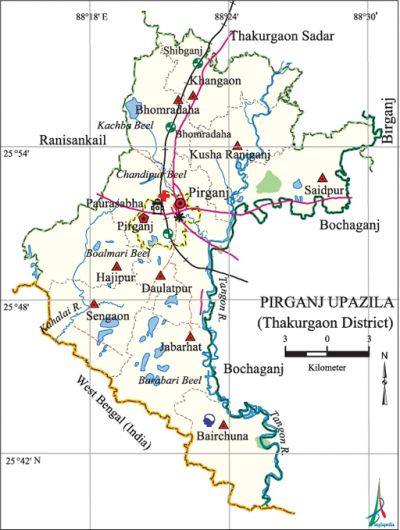Pirganj Upazila (Thakurgaon District)
Pirganj Upazila (thakurgaon district) area 353.30 sq km, located in between 25°40' and 25°59' north latitudes and in between 88°15' and 88°22' east longitudes. It is bounded by thakurgaon sadar upazila on the north, west bengal state of India on the south, birganj and bochaganj upazilas on the east, ranisankail upazila and West Bengal state of India on the west.
Population Total 215754; male 111458, female 104296; Muslim 151002, Hindu 61983, Buddhist 1461, Christian 68 and others 1240. Indigenous communities such as santal, oraon and Munda belong to this upazila.
Water bodies Main rivers: tangon, Kahalai; Kachba, Chandipur, Boalmari and Barabari Beels are notable.
Administration Pirganj Thana was formed in 1870 and it was turned into an upazila on 7 November 1983.
| Upazila | ||||||||
| Municipality | Union | Mouza | Village | Population | Density (per sq km) | Literacy rate (%) | ||
| Urban | Rural | Urban | Rural | |||||
|
1 |
10 |
168 |
168 |
27067 |
188687 |
611 |
53.0 |
39.5 |
| Municipality | ||||||||
|
Area (sq km) |
Ward |
Mahalla |
Population |
Density |
Literacy rate (%) | |||
|
16.84 |
9 |
11 |
23573 |
1400 |
52.6 | |||
| Union | ||||
| Name of union and GO code | Area (acre) | Population | Literacy rate (%) | |
| Male | Female | |||
|
Kusha Raniganj 69 |
8662 |
10006 |
9459 |
41.55 |
|
Khangaon 60 |
8850 |
9869 |
9059 |
39.35 |
|
Jabarhat 51 |
9848 |
11879 |
11378 |
38.99 |
|
Daulatpur 34 |
7068 |
7407 |
6789 |
41.79 |
|
Pirganj 77 |
5475 |
8753 |
8208 |
47.14 |
|
Bairchuna 23 |
9162 |
10568 |
9818 |
43.93 |
|
Bhomradaha 25 |
7202 |
10354 |
9604 |
35.55 |
|
Sengaon 94 |
8880 |
9534 |
9073 |
34.95 |
|
Saidpur 86 |
8531 |
9446 |
9237 |
41.03 |
|
Hajipur 43 |
8685 |
11335 |
10405 |
35.68 |
Source Bangladesh Population Census 2001, Bangladesh Bureau of Statistics.

Archaeological heritage and relics Tomb of Pir Sheikh Sirajuddin (R), ancient temple at village Dhemtia.
Historical events tebhaga movement under Haji mohammad danesh was held in this region. On 17 April 1971, the Pak army brutally killed a number of Bangalis on the road side of the Bhatarmari Farm of Pirganj upazila. Pirganj was liberated on 9 December.
Marks of the War of Liberation Mass grave 1 (adjacent to the Pirganj Madrasa).
Religious institutions Mosque 37, temple 40, church 2, tomb 2.
Literacy rate and educational institutions Average literacy 41.3%; male 48.1%, female 34%. Educational institutions: college 22, secondary school 83, primary school 172, madrasa 28. Noted educational institutions: Pirganj Degree College (1964), Pirganj Pilot High School (1907), Jabarhat High School (1960), Pirganj Banik Government Girls' High School (1970), Jabarhat Government Primary School (1929), Pirganj Model Government Primary School (1933), Bhadua Government Primary School (1934), Pirdangi SI Senior Madrasa (1965), Bhamda Senior Madrasa (1965), Hatpara Fazil Madrasa (1976).
Newspapers and periodicals Irregular: Sargam, Cinchon, Batikrom, Spondon, Charpatra, Dipalok, Rabindra Smranika, Bir Bangali, Raktakto Prantor, Durbadal, Rokter Rang Nil, Rokta Jhara Din; periodical: Oikantik, Samakal, Mukul, Abe Hayat; anaully: Siri.
Cultural organisations Library 5, club 58, theatre group 2, cinema hall 2, auditorium 2, playground 38.
Tourist spots Saguni Shalban (Shal Forest) and Thumnia Shal Forest.
Main sources of income Agriculture 77.34%, non-agricultural labourer 1.95%, industry 0.40%, commerce 10.05%, transport and communication 2.30%, service 3.82%, construction 0.96%, religious service 0.12%, rent and remittance 0.18% and others 2.88%.
Ownership of agricultural land Landowner 56.40%, landless 43.60%; agricultural landowner: urban 46.37% and rural 57.76%.
Main crops Paddy, wheat, sugarcane, maize, potato, vegetables.
Extinct or nearly extinct crops Aus paddy, jute.
Main fruits Mango, jackfruit, guava, banana, papaya, watermelon.
Fisheries, dairies and poultries Dairy 30, poultry 23.
Communication facilities Pucca road 80 km, mud road 586.8 km; railway 18 km.
Extinct or nearly extinct traditional transport Palanquin, bullock cart.
Noted manufactories Rice mill 1, oil mill 10, chira (threshed rice) mill 50, husking mill 241, saw mill 12, biscuit factory 5, chanachur factory 30, shoe factory 3, welding factory 21.
Cottage industries Goldsmith, blacksmith, potteries, embroidery, bamboo work, wood work, jute work.
Hats, bazars and fairs Hats and bazars are 30, most noted of which are Pirganj College Hat, Nasibganj Hat, Jabarhat, Nakati Hat, Khangaon Hat, Kaliaganj Hat, Bhabnaganj Hat, Kalupir Hat and Lohagara Hat.
Main exports Paddy, rice, watermelon, vegetables.
Access to electricity All the wards and unions of the upazila are under rural electrification net-work. However 9.55% of the dwelling households have access to electricity.
Sources of drinking water Tube-well 94.79%, tap 0.31%, pond 0.11% and others 4.79%.
Sanitation 5.38% (rural 3.50% and urban 18.90%) of dwelling households of the upazila use sanitary latrines and 24.14% (rural 22.37% and urban 37.14%) of dwelling households use non-sanitary latrines; 70.48% of households do not have latrine facilities.
Health centres Upazila health complex 1, satellite clinic 2, union health and family welfare centre 9, clinic 1.
Natural disasters The floods of 1987 and 1988 caused heavy damages to settlements and crops of the upazila.
NGO activities Operationally important NGOs are brac, asa, RDRS, World View. [Abu Md. Iqbal Rumi Shah]
References Bangladesh Population Census 2001, Bangladesh Bureau of Statistics; Cultural survey report of Pirganj Upazila 2007.
